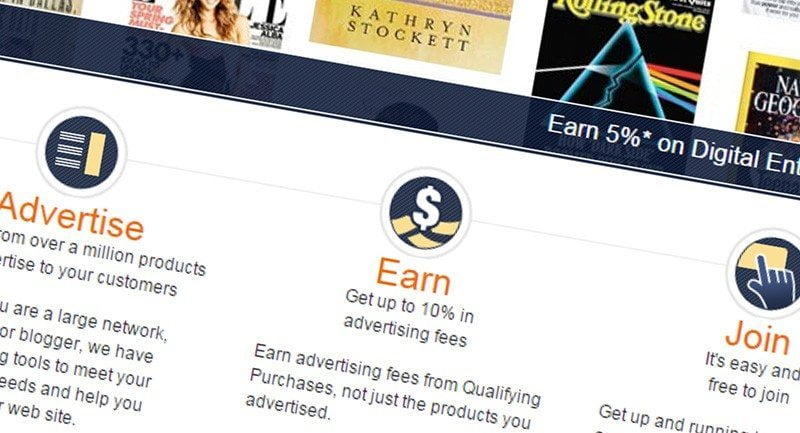Anyone who has ever dreamed about sitting back while their website or blog brings in income for them needs to know about monetization. The process of monetizing your website involves running advertising, offering a product, selling ad space on your page or any one of dozens of other ways to turn a profit using your online presence. Generating revenue won’t happen overnight, or without some effort, but in the end you can create automated channels of on-going income if you’re willing to set your site up for success from the start!
Website monetization can be as simple as you make it, and often a website will use a mix of different techniques in order to build revenue. If you’ve ever wanted to make money in your spare time using your blog or website, then you can’t afford to miss our list of the top 5 ways to monetize your website.
#1 – Direct Sales

Almost everyone is familiar with the direct sales model, even if it doesn’t seem like it at first. Direct sales is simply the process of charging your customers for a product or information. For example, an artist who makes prints of their work and sells the online is using a direct sales model. There are a few variations on direct sales, so if you aren’t an artist but the idea still interests you, it’s still a model that you can use.
One way that online entrepreneurs take advantage of direct sales, aside from the obvious exchange of homemade or re-sold goods, is by selling information. Nearly everyone has some sort of unique experience or skill that others would pay to learn. It’s very possible to monetize your blog by selling an eBook or video that explains what you know, step-by-step and in a lot of depth.
This sort of direct sales system works well for hobbyists and people who run blogs on a topic they’re passionate about. In a lot of cases, most of the initial investment will be your time, since it doesn’t cost a lot to write an eBook or record a video about a hobby that you’re already invested in. As long as you’re an expert on some small area of interest, and you find the right advertising partners to drive in the traffic, direct sales of information can be a low-risk, high-reward method of website monetization.
The direct sales model does have a few pitfalls. For example, sometimes people lose sight of how appealing a certain skill can be to the general public. You might think “worm farms” are exciting and amazing but the general public might not agree. You have to know and have identified specific target markets and target customers for direct sales to work. In most cases doing a little bit of research can tell you all you need to know about the market you are looking to sell within.
A good point to remember, if there are other people selling in your market space that typically means it’s something people want. If you seem to be the only one offering the product there might just be a good reason to steer clear and find something more agreeable to the masses, unless of course your product is new, innovative, or proprietary in nature.
Another challenge of direct sales could be that your sales are seasonal, since most people interested in a video about organic gardening, for example, wouldn’t be as interested in buying it when the weather is cold.
A website that’s been monetized with a direct sales model might also need an initial investment in advertising in order to draw paying customers to your website.
The core of any direct sales website is shopping cart software. There are a lot of different packages to choose from, and most of them are mature enough that they’re very easy to install and use. Website platforms such as WordPress has numerous shopping cart options that can be installed and integrated directly into an existing website. There are also other 3rd party platforms that can provide the shopping interface as well as the cart and checkout features you would need to complete the sale. Our best advice would be, look at your competitors or sites similar to your own. How are they handling sales? What could you do better? Faster? More cheaply?
Finally, we mentioned reselling products. Reselling is a twist on the direct sales model, and online resellers only earn a margin of every sale because of the cost of buying the product initially. Reselling has largely been taken over by affiliate programs, which we’ll touch on below, but bargain hunters can still supplement their income with it. Reselling often requires either a large existing inventory or a willingness to risk capital up front in order to make profits down the road, and for that reason it’s fallen out of fashion a bit over the past decade. There are also vendors such as Amazon who provide a service called “Fullfilled by Amazon (FBA).” This service allows you to send Amazon your inventory directly, then sell it through their website and they handle all packaging, shipping, and customer service after the sale… all for a reasonable cost. There are many other vendors who provide similar services as well, although none as robust and freeing as Amazon’s.
#2 Ad Revenue

There are a few different options when it comes to including advertising on your website. Banner and sidebar ads tend to be larger and more obtrusive, but the revenue per ad is much higher. Text ads, for instance the ones offered by Google’s AdSense program, offer less money per ad view but also integrate very well into your website and are tolerated better by your customers. This is because they can flow within the text and look more natural than a bold advertisement sitting all alone in the header or sidebar.
In order to actually get the ads on your page, there are a few options. In many cases if you have a WordPress website, there are plugins that will rotate and manage the advertising with very little input needed from you if at all. The same is true for Google’s AdSense. Some advertisers, especially smaller niche ones, will need you to paste JavaScript or HTML code directly into the template of your website. Usually this is easy enough to do without any help from a professional, but in some cases you’ll need to consider hiring a web developer for a one-time cost in order to get the job done.
Website monetization with ad revenue has a few unique drawbacks, although it is probably the method that’s most widely used. First, it’s important not to go overboard. If your customers perceive your website as cluttered or “spammy” they might not be eager to come back, even if you have content that they can’t get anywhere else.
Another thing to keep in mind with an ad-based program is that many online consumers are getting savvier. The use of ad blocking software is pretty popular, and it can cut into your revenues. Of course, there are blog extensions and other products available that you can use in order to deny access to anyone trying to ignore your ads, but sometimes this is perceived as being heavy-handed and intrusive. In general, since only a fraction of your visitors will be running software that blocks banner ads, it’s a problem that won’t hurt a healthy website.
Lastly, make sure you choose an ad vendor that will be pushing ads that are in the same general ballpark as your content. If your page is about rotary engines and the ads are for a subscription to Healthy Living Magazine, that will not lead to a whole lot of clicks. Relevant ads based on your page content should be very important in choosing the ad vendor to work with.
Again, website monetization with ad revenue is very popular and the benefits far outweigh the risks. In most cases it’s entirely free, easy to get running on your web pages, and generates passive income with every visitor. Every online entrepreneur should consider monetizing their website with ads.
#3 Affiliate Programs

Selling products through affiliate programs is a very popular method of website monetization. Most people use Amazon’s affiliate program, but there are many online retailers out there who sell products that fit into your site’s niche. The way affiliate programs work is pretty simple. You create content that features products that are available for sale online, and if people click and purchase the products by clicking on your link to get to the vendors website, you get a percentage of the sale.
Programs such as Amazon’s affiliate program have advantages over other programs. Their commission percentage might be a bit lower but there is a lot of opportunity to earn more, since any product purchased in addition to the product link they clicked from your website is available for commission as well. So if you have an affiliate link for a specific computer monitor, and when purchasing the monitor the customer also buys a computer, an external hard drive and some blank Blu-ray discs. You would get commissions on all four items, not just the monitor!
Affiliate programs are very easy to implement and manage, and nearly every major online retailer makes the tools that you need to get started available for free. In the case of Amazon, not only do they provide customized links to the item, but they also have tools available so that you can create slideshows of items for sale, randomized sidebar ads that feature a set of products that you pick, and other options like banners and scripts that feature the products in a clean, professional way.
There are two main concerns when monetizing your website with an affiliate program. First, affiliate programs are extremely popular, so you’ll be competing with a lot of other established websites and newcomers for traffic. Affiliate revenue takes time and a lot of effort to build up. If your blog or website is already popular, then this isn’t as much of a problem, but if you’re just getting started then you’ll want to advertise to drive more traffic to your website as well.
Also, the majority of affiliate programs have relatively low rates of return that you’ll be paid for selling. For example, Amazon pays between 4% and 6% of the sales price of the item to you for every purchase. This limits successful affiliate websites mostly to big ticket or very popular retail items, and can have an impact on your overall sales. It’s also important to remember that affiliate sales can be extremely seasonal, with the Christmas shopping season bringing in an oversize chunk of your products. With such a low payout percentage you have to weigh the pros and cons of driving traffic to your site to click on a product link(s) that only nets you less than 10% of the sale.
The benefits of affiliate sales are obvious, though. You don’t need to stock any items or handle any part of the sales process. All sales are handled through established third-parties and you can benefit from the legitimacy of large retail marketplaces. Plus getting started with nearly every affiliate program is entirely free. There are also a lot of WordPress plugins available for little or no cost which can help to automate the affiliate sales process, and technical support is easy to get.
If there are products that naturally fit well within your content and you already have quality traffic on your website, you may find affiliate marketing a breeze.
#4 Paid Posts

Popular blogs have a large readership base that retailers are looking to be able to reach out to directly. To this end, many blogs and websites sell space to manufacturers and retailers and allow them to produce and run content about their products and services. Paid posts are an increasingly popular way to monetize a website, and they’re hot right now in the online advertising community where quality content is a top SEO ranking factor. In fact, if you run a popular website, it’s possible that you’ve been approached with an offer already.
One of the biggest pros of paid posts are the fact that they generate content for your website at the same time as they bring in revenue. Not only are you able to free up resources that you’d typically use to produce blog posts, product reviews or custom content, but you’ll be getting a check for simply running content that someone else has already created. This can help to “beef up” your website, ensure that you run fresh content every week, and put money in your pocket. Make sure the paid content is unique to your website only.
Also, the articles that retailers want to run on your website are typically very well done. Big companies have access to professional photographers and copywriters that a small site might not be able to afford, so you can rest assured that any paid posts are going to be innovative, helpful and high-quality.
In some cases paid posts can be a drawback. It may be possible, if your blog or website is very popular, to make more money with an affiliate program than paid posts. Of course, that means you’ll have to handle all of the writing and editing yourself, but that’s nothing new to an online entrepreneur! Also, if you overuse paid posts, your user base might catch on to the fact that they’re being advertised to rather than informed, and your numbers could drop. For that reason, it’s important to balance paid posts with original content.
Note: You shouldn’t always be selling something. It’s a turn-off and makes the intent of your product, content or website in general seem misguided. Instead try balancing your content with thought provoking or resourceful content that comes without a price and is accessible to all.
Another highlight of paid posts are the fact that they’re easy to publish. There’s no complicated coding, typically you’ll just paste an article that you’ve received online or in your email directly onto your website platform. It really couldn’t be simpler, and you’ll be using all of the same tools that you typically use to publish your own original content so there is no “learning curve” or need to get familiar with some kind of advertising system. Paid posts differ as to how the payment scheme is set up, and you might either be paid per-post or per-view.
#5 Membership Programs

Membership programs are the platinum option for website monetization. If you have a site that does extremely well, is publishing new content on a regular basis and is succeeding with a combination of other monetization methods, you can really supercharge your earnings with a membership program. It’s a bit rarer to start your site with a member’s only area in place, but it can be done as long as you run the best, most engaging content in your niche.
Just like with shopping cart software for direct sales, there are packages available to help you set up a membership program. Typically, if you use WordPress, it’s as easy as installing a plugin and marking some posts “members only” but there are a variety of different options. You’ll also need a mechanism in place, like a shopping cart, to sell the memberships and scheduling software to keep track of when they expire. Your best bet is to look into all-in-one software packages which cover everything you need to get started with website monetization using a membership program.
There are fewer drawbacks to running a membership program than you might think. One of the biggest dilemmas you will face is, you really have to deliver content that people are willing to pay for. Whether it’s in-depth articles, expanded discussion or discount deals on products, if you don’t offer clear benefits to your members then they won’t sign up or won’t continue paying the membership fee. Similar to our direct sales notes about knowing that there truly is a market for what it is you are interested in selling, make sure your membership offer is truly delivering an exclusive experience that someone would be willing to pay for.
Some people might think that having some content only available to members would discourage non-members from using your site, but that’s not the case at all. Users who already enjoy non-member content will be eager to sign up to see the rest, especially if you make membership available for a reasonable price. Do make sure you are still giving non-paying members enough quality content to sink their teeth into. If you don’t they will most likely never have interest in paying for more.
Compared to the rest of these methods, membership programs take more capital to set up, since they require the most software, and in some cases you’ll need a professional to install it. There is also a larger time investment as running a membership site will require more manual interaction than any kind of “set it and forget it” advertising might.
Still, the possibility of having hundreds or thousands of members paying you every month to get a look at your online content is obviously a motivating factor for any entrepreneur. Membership programs are high-risk, high-reward prospects, but if you have the traffic to make them work then no other website monetization method will pay off bigger than this one.












